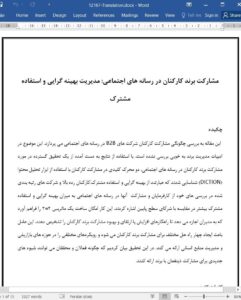Abstract
This article considers how employees engage with B2B firms on social media, a topic that is largely overlooked in the extant brand engagement literature. Using the results from a large-scale study of employee brand engagement on social media, we identify two key drivers of employee brand engagement using the content analysis tool DICTION—namely, optimism and commonality. Employees of top-ranked and -rated firms express higher levels of optimism and commonality in their reviews of their employers on social media than do their counterparts in bottom-ranked and -rated firms. This permits the construction of a 2 × 2 matrix that allows managers to diagnose strategies for increasing or improving employee brand engagement. This creates four different kinds of employee brand engagement situations, and offers human resources and marketing managers different strategies in each case. We demonstrate how practitioners and scholars can shed new light on the way stakeholders engage with brands.
1. Increasing a brand’s value
In the recent marketing literature, there has been a significant amount of attention dedicated to the concept of brand engagement, the process of how emotional or rational attachments are formed between customers or other stakeholders and brands (e.g., Baldus, Voorhees, & Calantone, 2015; Brodie, Hollebeek, Juri�c, & Ili�c, 2011; Brodie, Ili�c, Juri�c, & Hollebeek, 2013; de Villiers, 2015; Graffigna & Gambetti, 2015; Hollebeek, 2011; Hollebeek, Glynn, & Brodie, 2014). Brand engagement is an important concept in the marketing literature as it is strongly connected to brand equity or, put simply,the value of the brand. As articulated by Keller (2012), brand equity is often driven by a consumer’s association with a brand’s features and attributes and the ultimate engagement with the brand.
6. Final summary
This article considers brand engagement from a generally overlooked perspective: that of employees rather than customers. This is important because employee brand engagement impacts that of other organizational stakeholders, including customers, suppliers, and investors, often leading to virtuous or vicious cycles. Using the results from a large-scale study of employee brand engagement on social media, two key dimensions (optimism and commonality) are identified that differentiate between top-ranked and -rated brands and bottomranked and -rated brands. Employees of top-ranked and -rated firms express higher levels of optimism and commonality in their reviews oftheir employers on social media, and this enabled us to construct a 2 � 2 matrix that allows managers to diagnose strategies for employee brand engagement.











